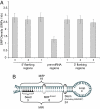Human polymorphism at microRNAs and microRNA target sites
- PMID: 17360642
- PMCID: PMC1805605
- DOI: 10.1073/pnas.0611347104
Human polymorphism at microRNAs and microRNA target sites
Abstract
MicroRNAs (miRNAs) function as endogenous translational repressors of protein-coding genes in animals by binding to target sites in the 3' UTRs of mRNAs. Because a single nucleotide change in the sequence of a target site can affect miRNA regulation, naturally occurring SNPs in target sites are candidates for functional variation that may be of interest for biomedical applications and evolutionary studies. However, little is known to date about variation among humans at miRNAs and their target sites. In this study, we analyzed publicly available SNP data in context with miRNAs and their target sites throughout the human genome, and we found a relatively low level of variation in functional regions of miRNAs, but an appreciable level of variation at target sites. Approximately 400 SNPs were found at experimentally verified target sites or predicted target sites that are otherwise evolutionarily conserved across mammals. Moreover, approximately 250 SNPs potentially create novel target sites for miRNAs in humans. If some variants have functional effects, they might confer phenotypic differences among humans. Although the majority of these SNPs appear to be evolving under neutrality, interestingly, some of these SNPs are found at relatively high population frequencies even in experimentally verified targets, and a few variants are associated with atypically long-range haplotypes that may have been subject to recent positive selection.
Conflict of interest statement
The authors declare no conflict of interest.
Figures





References
Publication types
MeSH terms
Substances
LinkOut - more resources
Full Text Sources
Other Literature Sources

